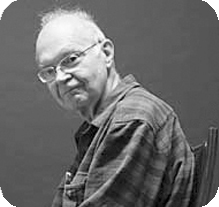
Donald ("Don") Ervin Knuth

In addition to the following English language editions, there are many translations of Knuth's books.
In his technical books and papers, Knuth often includes historical material, and sometimes explains his own involvement in the field. A reader interested in computing history can skim Knuth's writings looking for historical asides and personal comments.
Knuth does the typesetting for many of his books. Knuth's editor at Addison-Wesley, Peter Gordon, says that the Addison-Wesley production staff often gets PostScript files as the end product of Knuth's work, which they then convert into PDFs. The colophon of Volume 4A says:
This book was produced on an HP Compaq 2510p using Computer Modern typefaces, using TeX and METAFONT software as described in the author's books Computers & Typesetting (Reading, Mass.: Addison-Wesley, 1986), Volumes A—E. The illustrations were produced with John Hobby's MetaPost system.
Knuth uses the system he created to produce beautiful editions of TAOCP, and has control over every pixel on the page.
- The Art of Computer Programming, volumes 1 (1968), 2 (1969), 3 (1973), 4A (2011), and revised editions of various volumes, Addison-Wesley. This is the multi-volume book widely known as TAOCP. Volume 1 titled “Fundamental Algorithms” comprises chapters 1 and 2, Basic Concepts and Information Structures. Volume 2 titled “Seminumerical Algorithms” contains chapters 3 and 4, Random Numbers and Arithmetic. Volume 3 titled “Sorting and Searching” contains chapters 5 and 6, on Sorting and Searching. Volume 4A, titled “Combinatorial Algorithms Part 1” contains part of chapter 7 (ending with section 2.2.1).
- Concrete Mathematics: A Foundation for Computer Science, Second Edition, with Ronald Graham and Oren Patashnik, Addison-Wesley, 1994. This book teaches mathematics useful in the analysis of algorithms and is useful in the development of computer algorithms.
- Mathematics for the Analysis of Algorithms, Second Edition, with Daniel Green, Birkhäuser, 1982.
- Computers & Typesetting, volumes A-E (The TeXbook, 1984; TeX: The Program, 1986; The METAFONT book, 1986; METAFONT: The Program, 1986; Computer Modern Typefaces, 1986), Addison-Wesley. This is the comprehensive set of user manuals and documentation for the typesetting and font design system Knuth created (with help from his students) that revolutionized digital typesetting. The two "Program" books are examples of literate programming (see the 1992 book in bibliographic item [7]). Also see his “Digital Typography” book (1999 book in bibliographic item 7) and http://tug.org/TUGboat/Contents/listauthor.html#Knuth,Donald and http://www.tug.org/TUGboat/tb31-2/tb98panel.pdf
- The CWEB System of Structured Documentation, with Silvio Levy, Addison-Wesley, 1993. This is the system used by Knuth to develop and maintain literate programs, such as his TeX program and Stanford GraphBase program.
- The Stanford GraphBase: A Platform for Combinatorial Computing, ACM Press, 1994. This book describes use of the Stanford GraphBase system, a set of programs and datasets useful for studying graphs and networks. The programs are literate programs written using the CWEB system. Knuth used this system for studying the combinatorial algorithms of volume 4A of TAOCP.
- Volumes of Knuth's collected papers published by the Center for the Study of Language and Information, Stanford, CA.: Literate Programming (1992, 13 papers), Selected Papers on Computer Science (1996, 16 papers), Digital Typography (1999, 34 papers), Selected Papers on Analysis of Algorithms (2000, 34 papers), Selected Papers on Computer Languages (2003, 25 papers), Selected Papers on Discrete Mathematics (2003, 41 papers), Selected Papers on Design of Algorithms (2010, 28 papers), Selected Papers on Fun and Games (2010, 49 papers), Companion to the Papers of Donald Knuth (2011, an overall index to all nine volumes, 11 interviews of Knuth, and a few other pieces not in the prior eight volumes).Each of these volumes has a preface by Knuth that provides context for the paper,; and some of the 240 papers have a new introductory note. A few of the papers in these volumes had not been previously published.
- 3:16 Bible Texts Illuminated, A-R Editions, Madison, Wisconsin, 1990. In this book Knuth applies statistical analysis to Bible study. As with all his books, Knuth digs deep in his research, synthesizes masterfully, and takes great care to produce a beautiful book that includes 60 original illustrations by leading calligraphers).
- MMIXware: A RISC Computer for the Third Millennium, Heidelberg: Springer-Verlag, 1999 A description of the hypothetical computer to replace the MIX computer




























 THE A.M. TURING AWARD
THE A.M. TURING AWARD